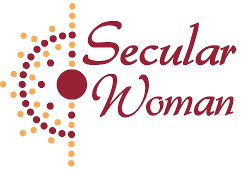Dana Ellyn is a visual artist based in Washington, DC, whose work frequently reflects atheist and vegetarian themes informed by her own values. Her art was featured at CFI’s Blasphemy Day event last year with a special exhibit that drew vitriolic controversy, including death threats, for provocative images such as “Jesus Does His Nails,” which depicts Jesus painting a nail driven through his hand. She describes her style as “on the fence between social realism and expressionism”; in this lightly edited interview, she shares her thoughts behind her work, her principles, and blasphemy. For more on Dana Ellyn, check out her website here.
JB: You’ve said your paintings are too gruesome for some. What is the goal of that type of work?
DE: I didn't go down the road of painting about religion as any sort of mission to upset people. Quite the opposite. It was truly a self exploration. As I learned about religion I also learned about me and my feelings on the subject.
It's something I really never discussed with anyone (or even myself to any deep level) until I was about 30 years old. I pondered, I painted, I posted [the paintings] to my website and put them in shows. It wasn't until I started to see and hear the reactions of others that I realized how strong some of my messages were and how they came across to others.
Nonbelievers applauded them. I assume many believers shrugged them off (these are the people I didn't hear from). others were deeply offended. Some threatened me. This wouldn't have taken me by surprise had I given it more thought––but like I said, I was creating these for my own self exploration. Kind of like a diary. But diaries are private, and I create paintings for a living so my paintings didn't stay private.
Once I reconciled all of this I decided I was completely comfortable putting my work out there and taking the criticism. Heck, these are my opinions and I'm free to express them. I paint about politics all the time and although plenty of people disagreed with one view or another, they never said I "shouldn't" paint something about politics. But, when it came to religion I was being held to a different standard, as if I don't have the right to express my opinion when it comes to religion because it upsets people. The whole idea of religion being sacred obviously doesn't hold any weight for me. So I continued painting work with religious content with confidence of my convictions. I stand behind my paintings by saying that I wouldn't paint anything that I'm not comfortable saying out loud in words to someone. In other words, I've had some very controversial ideas that I have never painted because they are just too over-the-top. Kind of like a comedian telling a joke that's so off color that even though it's their job to make jokes, their audience still turns on them because they've gone too far.
I think it's extremely important for art to elicit a reaction. But I have a line I aim not to cross. I have never painted something with the sole intent of pissing someone off. I've known that I *will* piss people off with much of my work but that is not my motivation. The motivation has to be because I was inspired by an idea and I have an opinion to express––an opinion I'm comfortable discussing.
The same thing goes for my veg-themed art. Some people have accused me of going "too far" with these paintings too, although I never expected vegetarians/vegans to be able to be offended by paintings about vegetarianism. But I do understand that even though vegetarians agree that animal abuse is bad and the meat industry is gruesome, they don't necessarily feel comfortable seeing it on canvas. For example, my "Baby Back Ribs" painting continues to scare and horrify people at every turn.
JB: How do you differentiate between shocking to challenge preconceptions, which is what Blasphemy Day is supposed to be about, and the common theist accusation that atheists are just being “disrespectful” or that certain media is “unnecessary”?
DE: Before exhibiting as part of Blasphemy Day, I was unaware of all the internal strife, if you will, in the atheist community. I stepped on a proverbial land mine with this show. I was just painting what I paint and I was invited to hang them for Blasphemy Day. I had no idea it was associated with the anniversary of the Mohammed cartoons when I first agreed to do it. I'd read books by Dawkins and Hitchens and Harris and was aware of the different tactics they each employ when delivering their messages. But I wasn't expecting the blowback from within the atheist community to my work. Can of worms. My most difficult but most rewarding interview was with Fox News. Their religion correspondent came at me guns a-blazing with accusation after accusation. I took each of her accusations, calmly explained my position, and diffused her at every turn. It was brilliant. The end of that episode is that she ran the story about the infighting in the atheist community and left my name and my art completely out of it. It was a great reminder to me that I was in fact confident in my position and that, when given the chance, could sometimes make a religious person understand that I have a right to not believe as much as they have a right to believe.
JB: Have you ever regretted publishing or sharing a work of art?
DE: No regrets.
